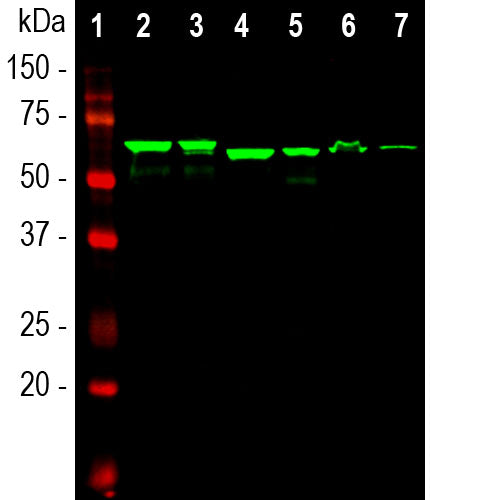

EnCor Biotechnology
Mouse Monoclonal Antibody to α-Internexin/NF66, Cat# MCA-1D2
Description
MCA-1D2 was made against full length recombinant rat α-internexin expressed in and purified from E. coli which binds to the α-internexin protein from different mammals, including human and mouse. It is clean and specific on western blots, ICC and IHC. We also supply an alternate mouse monoclonal antibody, MCA-2E3, a rabbit polyclonal antibody, RPCA-a-Int, and a chicken polyclonal antibody, CPCA-a-Int to this protein.
- Cell Structure Marker
- Cell Type Marker
- Cytoskeletal Marker
- Developmental Marker
- Immunohistochemistry Verified
- Mouse Monoclonal Antibodies
Add a short description for this tabbed section
| Name: | Alpha-internexin/NF66, mouse monoclonal antibody, Cat# MCA-1D2 |
| Immunogen: | Full length recombinant rat α-internexin expressed in and purified from E. coli. |
| HGNC Name: | INA |
| UniProt: | P23565 |
| Molecular Weight: | 64-66 kDa by SDS-PAGE |
| Host: | Mouse |
| Isotype: | IgG1 |
| Species Cross-Reactivity: | Human, Cat, Rat, Mouse |
| RRID: | AB_2572334 |
| Format: | Protein G affinity purified antibody at 1mg/mL in 50% PBS, 50% glycerol plus 5mM NaN3 |
| Applications: | WB, IF/ICC, IHC |
| Recommended Dilutions: | WB: 1:10,000. IF/ICC: 1:5,000. IHC: 1:1,000-1:2,000. |
| Storage: | Store at 4°C for short term, for longer term store at -20°C. Stable for 12 months from date of receipt. |
α-internexin is a Class IV intermediate filament protein originally discovered by two different groups of researchers as it copurifies with NF-L, NF-M and NF-H, the better known major neurofilament "triplet" subunits (1,2). It is expressed only in neurons and in large amounts early in neuronal development, but is down-regulated in many neurons as development proceeds. Some neurons express α-internexin in the absence of NF-L, NF-M and NF-H, though most mature neurons express all four proteins. α-internexin antibody has been shown, in peer reviewed publications, to reveal the upregulation of α-internexin in facial neurons following experimental axotomy followed by down regulation on axonal regeneration (3). It has also been used to identify and classify patients with neurofilament inclusion body disease, a specific form of frontotemporal lobar dementia (4-6). Finally it can be used to confirm the presence of circulating antibodies to α-internexin in the blood of certain patients with endocrine autoimmunity (7).

Chromogenic immunostaining of a 4% PFA fixed paraffin embedded rat cerebellum section with mouse mAb to α-internexin, MCA-1D2, dilution 1:1,000, detected in DAB (brown) following the Vector Labs immPRESS® method with citrate retrieval. Hematoxylin (blue) was used as the counterstain. The 1D2 α-internexin antibody labels parallel fibers and other neuronal processes in both rat and human brain. This antibody performs well in testing with both 4% PFA and standard NBF fixed tissues but does not stain long term NBF fixed tissue effectively. We therefore recommend our alternate mouse monoclonal antibody to α-internexin MCA-2E3 for such paraffin applications. Mouse select image for larger view.
1. Pachter J and Liem RKH. Alpha-Internexin, a 66-kD intermediate filament-binding protein from mammalian central nervous tissues. J Cell Biol 101:1316-22 (1985).
2. Chiu FC, et al. Characterization of a novel 66 kd subunit of mammalian neurofilaments. Neuron 2:1435-45 (1989).
3. McGraw T. et al. Axonally transported peripheral signals regulate alpha-internexin expression in regenerating motoneurons. J Neurosci. 22:4955-63 (2002).
4. Evans J. et al. Characterization of mitotic neurons derived from adult rat hypothalamus and brain stem. J. Neurophysiol. 87:1076-85 (2002).
5. Cairns NJ. et al. Alpha-internexin is present in the pathological inclusions of neuronal intermediate filament inclusion disease. Am . J. Pathol. 164:2153-61 (2004).
6. Uchikado H1, Shaw G, Wang DS, Dickson DW.
Screening for neurofilament inclusion disease using alpha-internexin immunohistochemistry. Neurology 64:1658-9 (2005).
7. Rajasalu T, et al. Demonstration of natural autoantibodies against the neurofilament protein alpha-internexin in sera of patients with endocrine autoimmunity and healthy individuals. Immunol. Lett. 94:153-60 (2004).
Add a short description for this tabbed section





